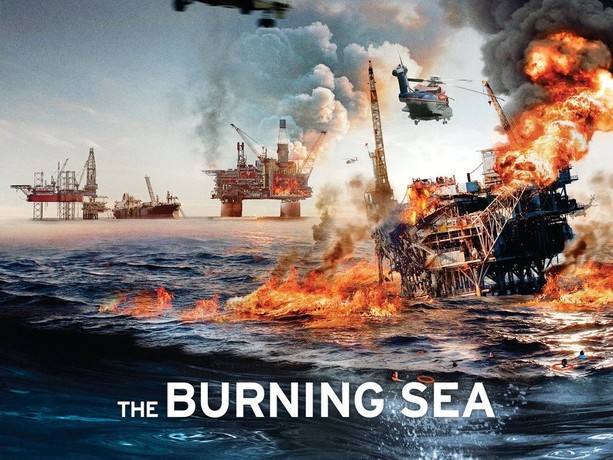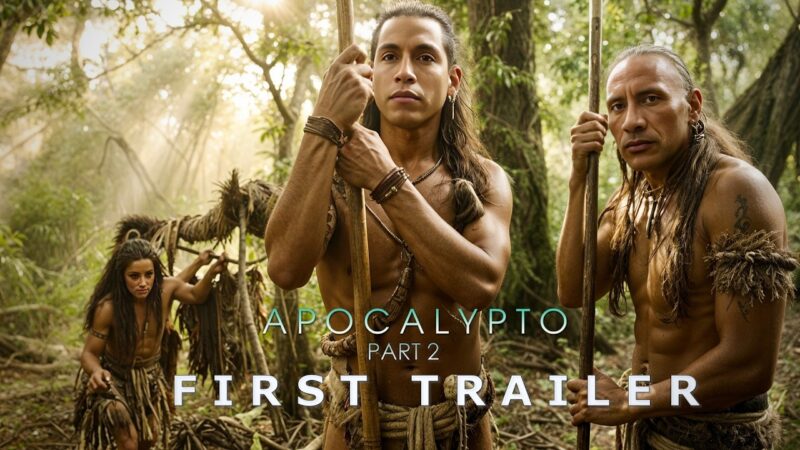🔥 𝙏𝙃𝙀 𝘽𝙐𝙍𝙉𝙄𝙉𝙂 𝙎𝙀𝘼 (𝟮𝟬𝟮𝟭)

The Burning Sea (2021): A Gripping Norwegian Disaster Thriller

Introduction
The Burning Sea (original title: Nordsjøen), released in 2021, is a Norwegian disaster thriller that plunges audiences into the heart of an environmental catastrophe in the North Sea. Directed by John Andreas Andersen and produced by Fantefilm, the team behind The Wave (2015) and The Quake (2018), the film combines intense action, ecological themes, and deeply human drama. While it follows familiar disaster genre tropes, The Burning Sea stands out with its Nordic realism, impressive visual effects, and a sobering message about the consequences of unchecked oil drilling. This article provides a comprehensive look at the film’s plot, cast, production, audience reception, and the accuracy of the viral description circulating online.
Production and Release
The Burning Sea premiered in Norway on October 29, 2021, and was released internationally in 2022, including theaters and digital platforms in the United States on February 25, 2022. Produced by Fantefilm in collaboration with Nordisk Film and Creative Europe Media, the film was shot on location in Norway, including real oil rig sites, enhancing its authenticity. With a runtime of 1 hour 44 minutes, it is rated PG-13 for scenes of peril, some disturbing images, language, and brief partial nudity. The film was distributed by Magnolia Pictures in the U.S. and Minerva Pictures in Italy, among others, and is available for streaming on platforms like Hulu or for rent/purchase on Fandango at Home.

Directed by John Andreas Andersen (The Quake), the screenplay was written by Harald Rosenløw-Eeg and Lars Gudmestad, both veterans of the Norwegian disaster trilogy. The production utilized advanced CGI for underwater and explosion scenes, with water effects praised by critics for their realism, a notoriously challenging element to animate. The film was showcased at the 16th Rome Film Festival in October 2021 and sold to multiple markets across Europe, Asia, and the Americas.
Plot: A Human-Caused Catastrophe
Set against the backdrop of Norway’s oil industry, The Burning Sea opens with a prologue detailing the discovery of vast oil fields in the North Sea in 1969, transforming Norway into a prosperous “oil nation.” Fifty years later, the environmental cost of relentless drilling becomes evident. The story follows Sofia Hartmann (Kristine Kujath Thorp), a robotics engineer operating eel-like underwater robots for ocean exploration. When an oil rig collapses due to a gas explosion, Sofia and her colleague Arthur (Rolf Kristian Larsen) are dispatched to locate survivors and investigate the cause.

Their findings reveal a terrifying truth: excessive drilling has destabilized the seabed, causing a massive crack near the site of the ancient Storegga Slide, a prehistoric underwater landslide. This fracture threatens to collapse 350 oil platforms, trigger a catastrophic oil spill, and devastate the Norwegian coastline and beyond. As the crisis escalates, Sofia’s boyfriend, Stian (Henrik Bjelland), a rig worker, becomes trapped in an air pocket on the collapsed Gullfaks A platform. Sofia, alongside Arthur and emergency manager William Lie (Bjørn Floberg), races against time to rescue Stian and prevent an oil spill that could poison the Baltic Sea for centuries.
The government, informed by Lie, opts for a drastic solution: bombing the oil fields to burn off the concentrated oil before it spreads. This decision, depicted with haunting visuals of a flaming horizon, places Sofia, Stian, and Arthur in peril as they navigate the collapsing rig. The film balances personal stakes—Sofia’s determination to save Stian and his son Odin (Nils Elias Olsen)—with broader ecological warnings, culminating in a reflection on Norway’s identity as an “ocean nation” rather than an oil-dependent one.
Cast and Performances

The ensemble cast delivers authentic, relatable performances, a hallmark of Norwegian cinema that avoids Hollywood’s over-the-top heroics:
-
Kristine Kujath Thorp as Sofia Hartmann: A resilient and determined scientist, Thorp’s performance anchors the film with emotional depth and quiet strength.
-
Henrik Bjelland as Stian: Sofia’s boyfriend, a rig worker whose vulnerability and openness defy traditional “macho” stereotypes.
-
Rolf Kristian Larsen as Arthur: Sofia’s supportive colleague, bringing humor and camaraderie.
-
Bjørn Floberg as William Lie: A veteran SAGA executive balancing corporate loyalty with moral responsibility.
-
Nils Elias Olsen as Odin: Stian’s young son, heightening the personal stakes. Supporting roles include Anders Baasmo Christiansen, Anneke von der Lippe, and Christoffer Staib as the Oil and Energy Minister. Critics praised the cast’s authenticity, noting their “pale, boiler-suited” realism as a refreshing contrast to Hollywood stars like Dwayne Johnson.
Themes and Message
The Burning Sea is both a thrilling disaster film and a cautionary tale about environmental exploitation. It critiques the short-sighted greed of the oil industry, drawing parallels to real-world incidents like the Deepwater Horizon spill (2010), though not based on a specific event. The film suggests that Norway’s oil-driven prosperity has come at a steep cost, with drilling turning the seabed into “Swiss cheese” and risking ecological collapse. Its prologue and epilogue, styled like a mockumentary, underscore this message, framing the narrative as a warning of inevitable consequences if fossil fuel reliance continues.
However, some critics, like Variety, noted that the environmentalism feels “phoned in,” lacking the incisive edge of films like The China Syndrome or Dark Waters. The film avoids outright vilifying the oil industry, portraying workers like Sofia and Stian as well-meaning and executives as flawed but not malicious. This balanced approach has sparked debate, with some viewers appreciating its realism and others, particularly environmental activists, finding it too lenient on Norway’s oil policies.
Reception and Critical Response

The Burning Sea received generally positive reviews, earning a 6.3/10 on IMDb and a 79% audience score on Rotten Tomatoes. Critics praised:
-
Visual Effects: The water and explosion scenes, especially the climactic burning sea, were lauded for their realism and scale, rivaling Hollywood productions.
-
Acting: The cast’s naturalistic performances were a highlight, with Thorp’s Sofia earning acclaim as a compelling, non-stereotypical heroine.
-
Realism: The film’s grounded approach, avoiding over-the-top heroics, was seen as a strength, though some felt it lacked the intensity of Deepwater Horizon.
-
Message: Its ecological themes resonated, though some critics found them predictable or underexplored.
Drawbacks included a familiar disaster movie structure, with The Guardian calling it a “mildly eco-catastrophizing offering” that adheres too closely to genre tropes. The pacing was criticized as uneven, with a slow buildup and a rushed ending that some felt undercut the stakes. Indiewire noted that the generic characters, while relatable, lacked depth, making the personal drama less gripping than the ecological horror. Despite these critiques, the film was a commercial success in Norway and found a global audience, cementing Norway’s reputation for high-quality disaster cinema.
Accuracy of the Viral Description
The viral description captures the film’s essence but includes some exaggerations:
-
Accurate:
-
The film is from the creators of The Wave and The Quake, directed by John Andreas Andersen.
-
It centers on a collapsing oil rig in the North Sea, with a cracking seabed threatening a catastrophic chain reaction.
-
A female protagonist, Sofia, races to save trapped workers, including her boyfriend, amid escalating chaos.
-
The film blends action, suspense, and survival, with strong environmental themes.
-
-
Partially Accurate:
-
The phrase “the ocean itself swallows everything” is dramatic but not literal; the threat is an oil spill and platform collapses, not the ocean consuming the coastline.
-
“Scientists uncover a terrifying reality” oversimplifies the plot; Sofia and Arthur’s findings build on existing concerns about drilling.
-
-
Misleading:
-
The description’s hyperbolic tone (“when the ocean turns against us”) suggests a supernatural element, but the disaster is entirely man-made, stemming from drilling.
-
It implies a broader focus on “the entire coastline,” but the film primarily concerns the North Sea and nearby regions.
-
The viral description effectively markets the film’s intensity but exaggerates its scope to heighten drama, a common tactic in promotional materials.
Cultural and Industry Context
The Burning Sea is the third in an unofficial trilogy of Norwegian disaster films, following The Wave and The Quake. Unlike its predecessors, which focused on natural disasters (tsunami and earthquake), The Burning Sea tackles a man-made crisis, reflecting Norway’s complex relationship with its oil industry, a cornerstone of its economy. The film’s release coincided with growing global awareness of climate change, earning praise for its relevance, though some Norwegian critics, as noted on Letterboxd, felt it was overly conciliatory toward the oil industry, portraying Norway as “naive” rather than culpable.
The film also showcases Norway’s growing prowess in genre filmmaking. With a modest budget compared to Hollywood, it achieves blockbuster-level effects, a testament to Fantefilm’s expertise. The inclusion of real-world technology, like Eelume’s snake-like underwater robots, adds credibility, though the film takes liberties for dramatic effect (e.g., no divers or manned subs appear, contrary to the poster’s imagery).
Conclusion
The Burning Sea (2021) is a compelling addition to Norway’s disaster film canon, blending heart-pounding action with a timely environmental message. While it doesn’t reinvent the genre, its realistic characters, stunning visuals, and critique of oil dependency make it a standout. Kristine Kujath Thorp’s Sofia is a refreshing heroine, and the Scandinavian restraint sets it apart from Hollywood’s bombast. Despite a predictable structure and a somewhat rushed climax, it’s a gripping watch that resonates with eco-conscious audiences. Available on Hulu and digital platforms, The Burning Sea is a must-see for disaster movie fans and those intrigued by the fragile balance between industry and nature.
Stream The Burning Sea now on Hulu, or rent/buy on Fandango at Home, and brace for a thrilling dive into a man-made nightmare.
TRAILER MOVIE📺👇👇:





